Heatmap - Gravity
A color-coded map to visualize the accessibility of points (such as POI) from surrounding areas.
1. Explanation
Visualized as a color-coded hexagonal grid, the heatmap takes into account real-world transport and street networks to compute accessibility. After specifying a routing type (Walk, Bicycle, etc.), opportunity layer and travel time limit, the result will display a color-coded hexagonal grid for all areas accessible under these conditions. The color scale refers to local accessibility.
An Opportunity layer contains geographic point data. Select one or more such layers containing your destination points (opportunities) as input to the heatmap.
Unique to the gravity-based heatmap, customizable properties such as sensitivity, the impedance function and destination potential give you minute control over the method used and metadata taken into account while computing the accessibility value for an area. Influenced by these properties, the accessibility of a point can model complex real-world human behavior and is a powerful measure for transport and accessibility planning.
Described shortly, accessibility heatmaps are a visualization representing access from various unspecified origins, to one or more specified destinations. This is in contrast to catchment areas which represent egress from one or more specified origins to various unspecified destinations.
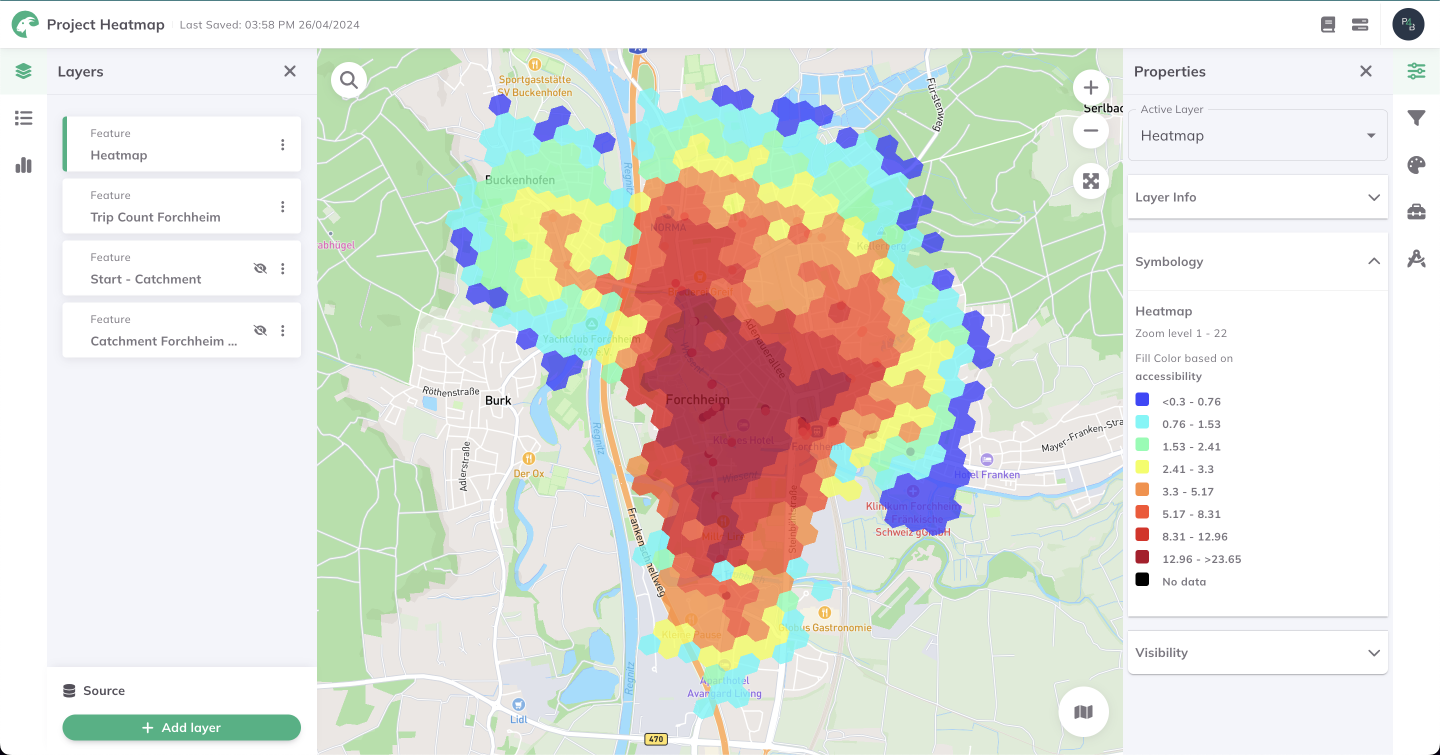
Heatmaps are available in certain regions. Upon selecting a Routing type, a geofence will be displayed on the map to highlight supported regions.
If you would like to perform analyses beyond this geofence, feel free to contact us. We would be happy to discuss further options.
2. Example use cases
Which neighborhoods or areas have limited access to public amenities, such as parks, recreational facilities, or cultural institutions, and may require targeted interventions to improve accessibility?
Are there areas with high potential for transit-oriented development or opportunities for improving non-motorized transportation infrastructure, such as bike lanes or pedestrian-friendly streets?
What is the impact of a new amenity on local accessibility?
Is there potential to expand the availability of services such as bike sharing or car sharing stations?
How does the accessibility in various neighborhoods compare when taking into account the qualitative aspects of amenities (such as frequency of service at bus stops, size of supermarkets, capacity of schools, etc)?
What is the real-world accessibility of public transport stations when travel times to these stations impact their accessibility in a non-linear way?
3. How to use the indicator?
Toolbox Accessibility Indicators menu, click on Heatmap Gravity.Routing
Routing Type you would like to use for the heatmap.- Walk
- Bicycle
- Pedelec
- Car
Walk
Considers all paths accessible by foot. For heatmaps, a walking speed of 5 km/h is assumed.
For further insights into the Routing algorithm, visit Routing/Walk.
Bicycle
Considers all paths accessible by bicycle. This routing mode takes into account the surface, smoothness and slope of streets while computing accessibility. For heatmaps, a cycling speed of 15 km/h is assumed.
For further insights into the Routing algorithm, visit Routing/Bicycle. In addition, you can check this Publication.
Pedelec
Considers all paths accessible by pedelec. This routing mode takes into account the surface and smoothness of streets while computing accessibility. For heatmaps, a pedelec speed of 23 km/h is assumed.
For further insights into the Routing algorithm, visit Routing/Bicycle. In addition, you can check this Publication.
Car
Considers all paths accessible by car. This routing mode takes into account speed limits and one-way access restrictions while computing accessibility.
For further insights into the Routing algorithm, visit Routing/Car.
Configuration
Impedance Function you would like to use for the heatmap.- Gaussian
- Linear
- Exponential
- Power
Gaussian
This function calculates accessibilities based on a Gaussian curve, which is influenced by the sensitivity and destination_potential you define. For a more in-depth understanding, refer to the Technical details section.
As studies have shown, the relationship between travel time and accessibility is often non-linear. This means that people may be willing to travel a short distance to reach an amenity, but as the distance increases, their willingness to travel rapidly decreases (often disproportionately).
Leveraging the sensitivity you define, the Gaussian function allows you to model this aspect of real-world behaviour more accurately.
How to choose the sensitivity value?
Selecting the best fitting sensitivity always depends on the context of the analysis, and there are no strict rules.
- Low β: A good strating point could be to use lower sensitivity on urban scale analyses, beacause it results in sharper accesssibility value drop with increasing travel time. In urban areas there are more opportunities available, and people are more likely to choose the closest one.
- High β: In contrast, higher sensitivity could be used in regional scale analyses, where opportunities are more sparse and people are more likely to travel further to reach them.
See the Calculation section for a detailed visual explanations on the formula.
Linear
This function maintains a direct correlation between travel time and accessibility, which is modulated by the destination_potential you specify. For a more in-depth understanding, refer to the Technical details section.
This feature is currently under development. 🧑🏻💻
Exponential
This function calculates accessibilities based on an exponential curve, which is influenced by the sensitivity and destination_potential you define. For a more in-depth understanding, refer to the Technical details section.
This feature is currently under development. 🧑🏻💻
Power
This function calculates accessibilities based on a power curve, which is influenced by the sensitivity and destination_potential you define. For a more in-depth understanding, refer to the Technical details section.
This feature is currently under development. 🧑🏻💻
Opportunities
Opportunities are essentially point-based data (such as POI) for which you would like to compute a heatmap. These are the "destinations" (such as transit stations, schools, other amenities, or your own custom point-based data) while surrounding areas are "origins" for which an accessibility value will be computed and visualized.
Additionally, you may create more opportunities via the + Add Opportunity button at the bottom of the drawer. All opportunity layers will be combined to produce a unified heatmap.
Opportunity Layer from the drop-down menu. This can be any previously created layer containing point-based data.Travel Time Limit for your heatmap. This will be used in the context of your previously selected Routing Type.Need help choosing a suitable travel time limit for various common amenities? The "Standort-Werkzeug" of the City of Chemnitz can provide helpful guidance.
Destination Potential Field. This must be a numeric field from your Opportunity Layer which will be used as a coefficient by the accessibility function.Destination potential is a useful way to prioritize certain opportunities over others. For example, if there are two supermarkets and one is nearer than the other, it would typically receive a higher accessibility score due to its proximity. However, if the supermarket farther away is larger, you may want to give it a higher level of importance. Destination potential allows you to use an additional property (such as the size of supermarkets) to assign opportunities a "potential" and employ qualitative information while computing accessibility.
The example below shows how the destination potential can affect the gravity heatmap. Its destination potential is based on the total number of hourly public transport departures from a stop. It will result in a different accessibility distribution, because the area around point with a higher destination potential will be favored in the computation.
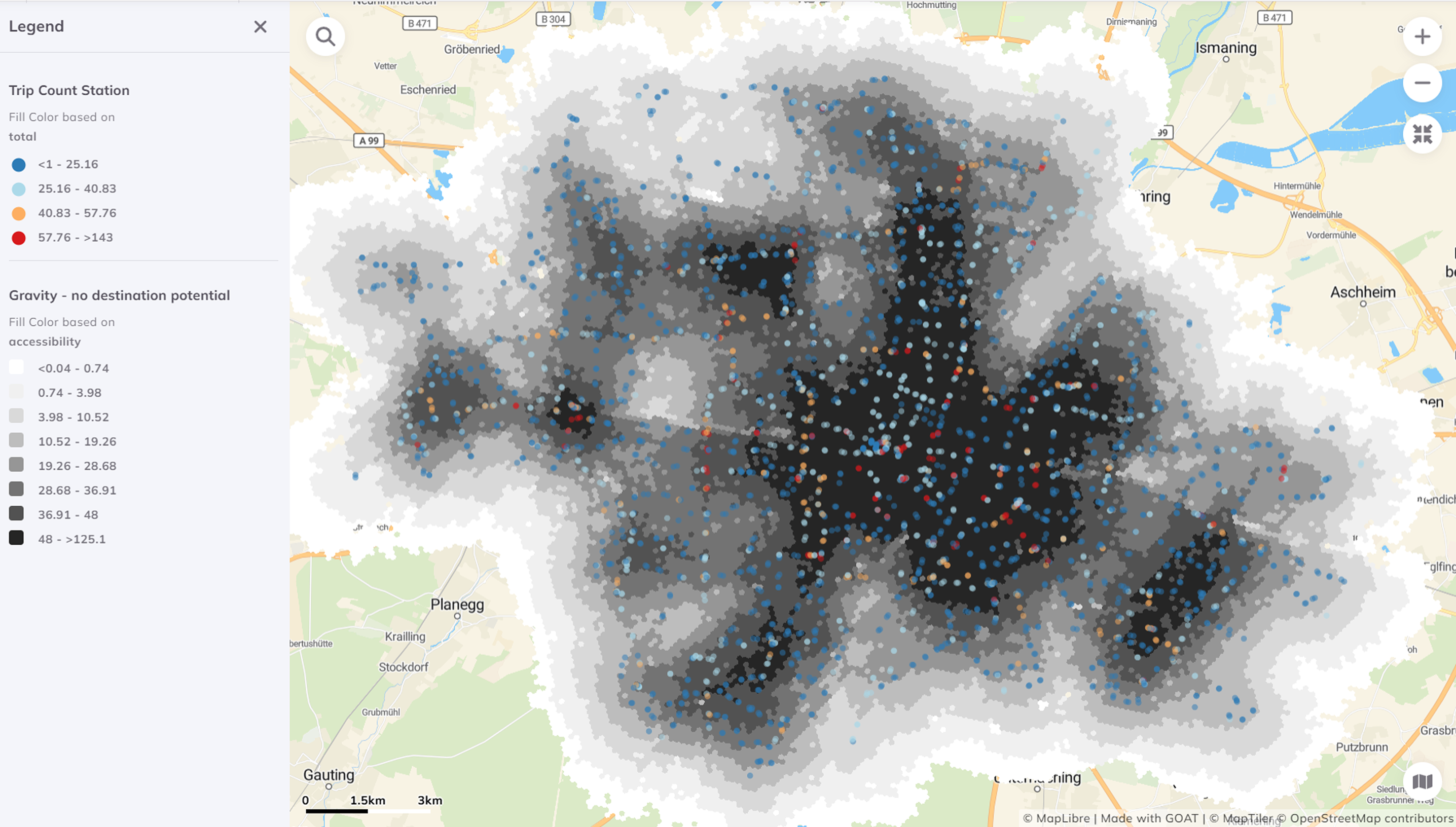
The first map is calculated without destination potential.
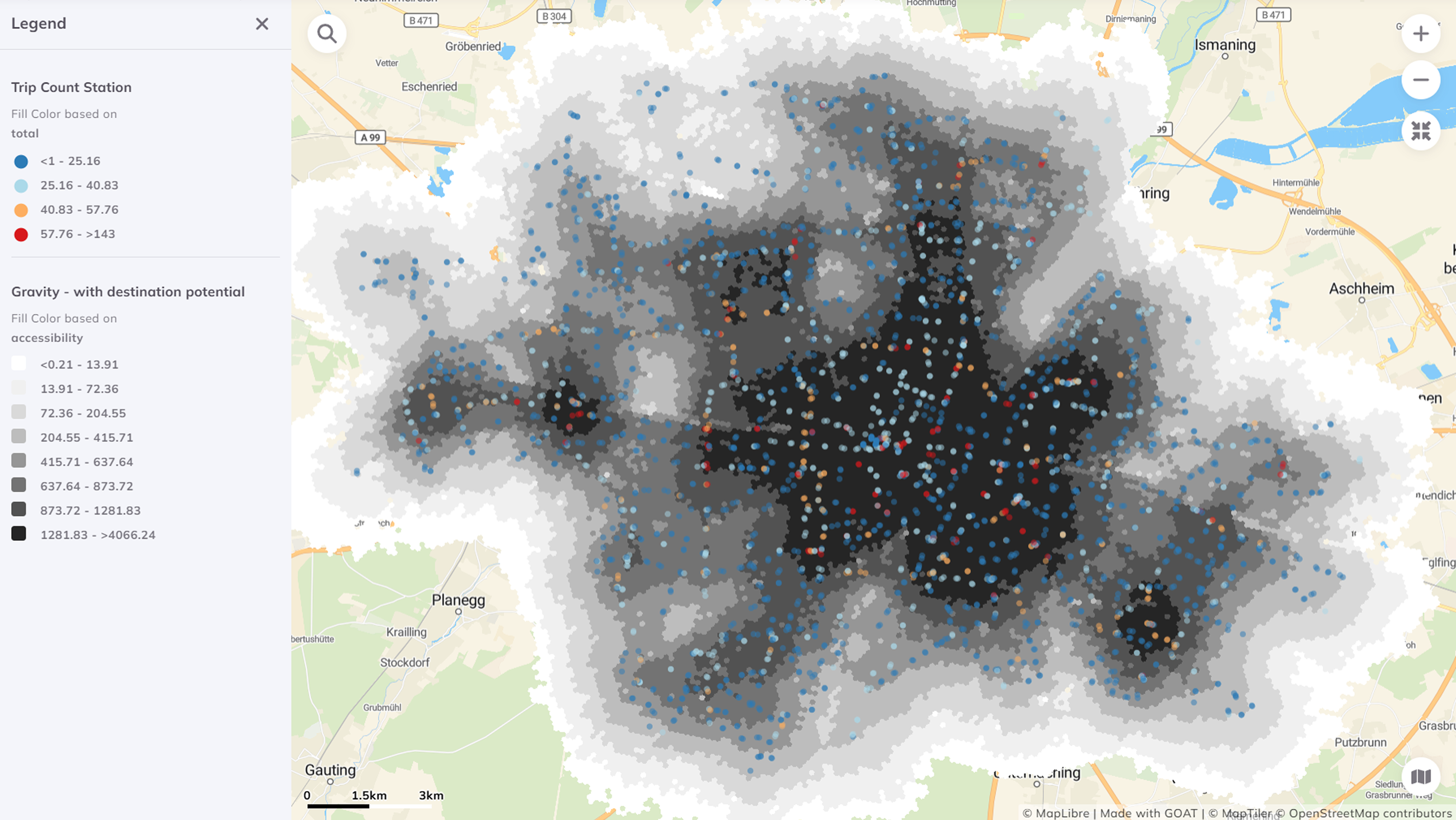
The second map used the same settings, but added destination potential based on the total number of departures. This altered the accessibility values of each hexagon and they returned in a wider range, because the highest value increased even more. Higher accessibility values are more concentrated around the stops that have larger trip count (red points).
Sensitivity value. This must be numeric and will be used by the heatmap function to determine how accessibility changes with increasing travel time.Run to start the calculation of the heatmap.Depending on your configuration, the calculation might take a few minutes. The status bar displays current progress.
Results
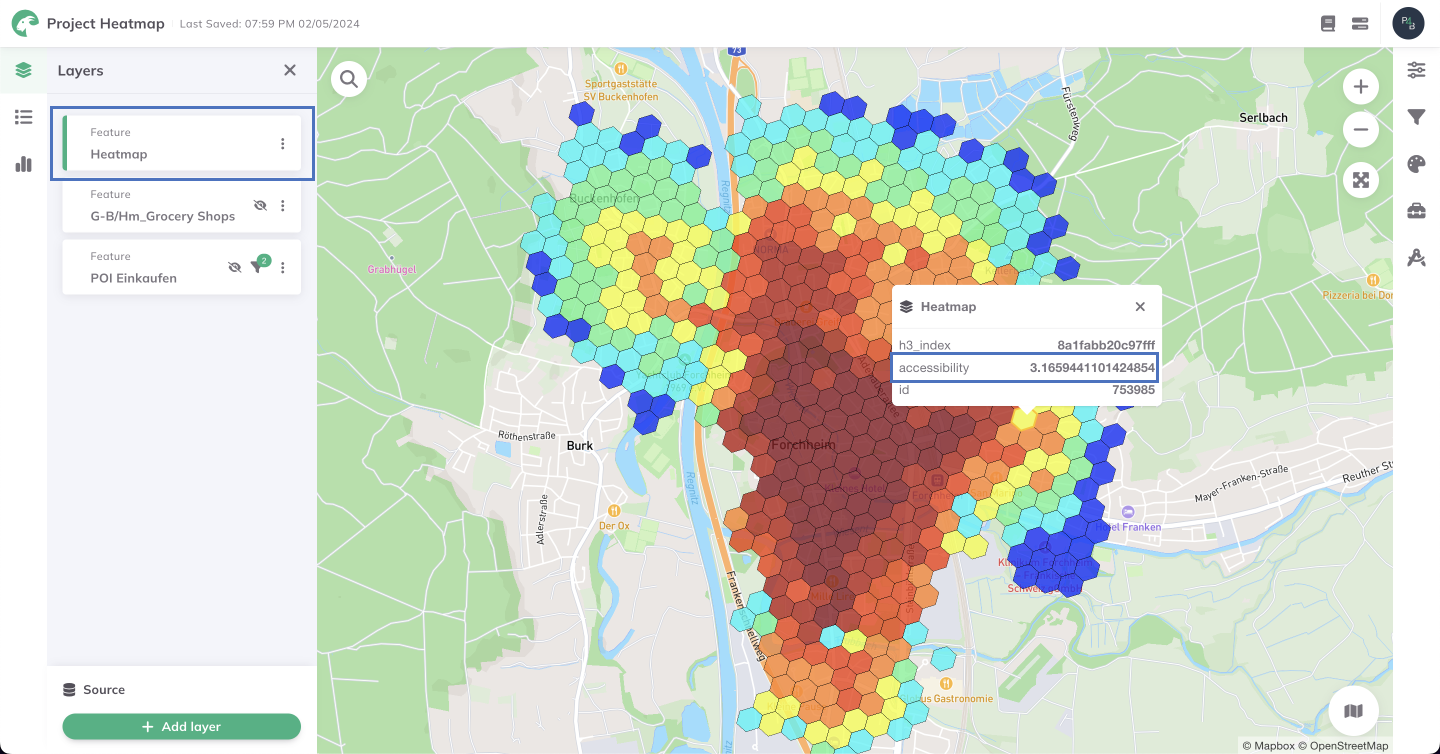
Want to style your heatmaps and create nice-looking maps? See Styling.
4. Technical details
Calculation
The accessibility value of each hexagonal cell within a heatmap is calculated with the help of gravity-based measures and can be operationalized as:
Accessibility Formula:
where the accessibility A of origin i is the sum of all opportunities O available at destinations j weighted by some function of the travel time tij between i and j. The function f(tij) is the impedance function, which can be gaussian, linear, exponential, or power. The sensitivity parameter β and the destination potential are used to adjust the accessibility value.
GOAT uses the following formulas for its impedance functions:
Modified Gaussian, (Kwan,1998):
Cumulative Opportunities Linear, (Kwan,1998):
Negative Exponential, (Kwan,1998):
Inverse Power, (Kwan,1998) (power in GOAT):
Travel times are measured in minutes. For a maximum travel time of 30 minutes, destinations that are farther than 30 minutes are considered non-accessible and therefore not considered in the calculation of the accessibility. The sensitivity parameter determines how accessibility changes with increasing travel time. As the sensitivity parameter is decisive when measuring accessibility, GOAT allows you to adjust this The graph shows how the willingness to walk decreases with increasing travel time based on the selected impedance function and sensitivity value (β).
Similarly, the destination potential can be changed. Thus, for example, one POI type (e.g. hypermarkets) can be assigned a higher accessibility effect than other POI types (e.g. discount supermarkets). In the Opportunities section, at step 7, we cover the destination potential in detail.
For a calculation example see our tutorial video.
Classification
In order to classify the accessibility levels that were computed for each grid cell (for color-coded visualization), a classification based on 8 quantile group is used by default. That means, each color covers 12,5 % of the grid cells. The area outside of the computed layer has no access within the defined travel time.
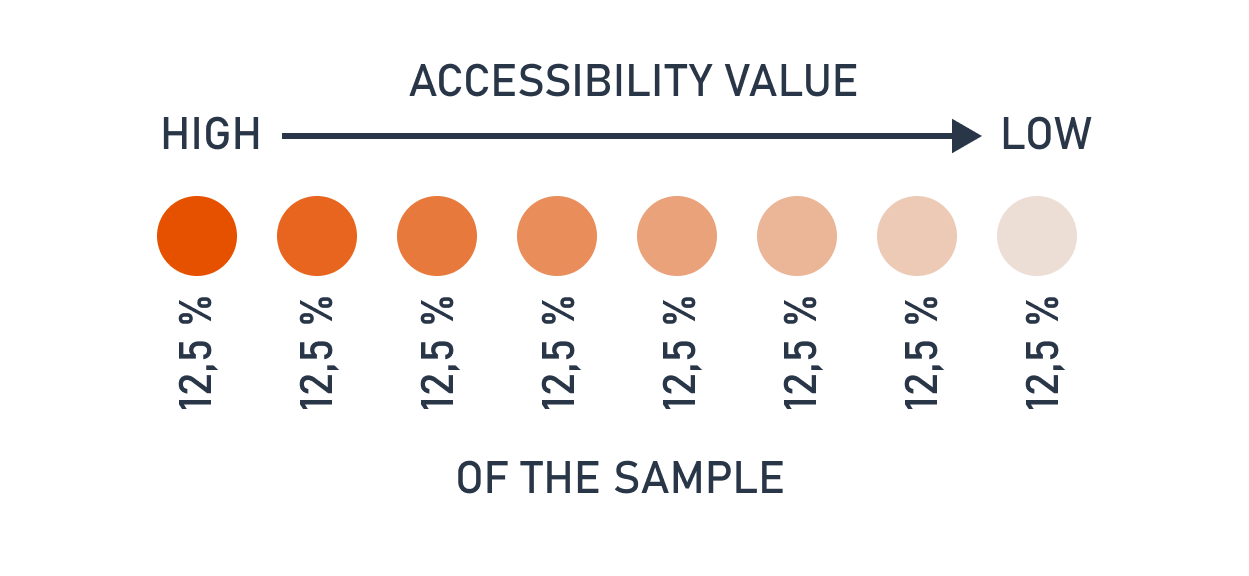
However, various other classification methods may be used instead. Read more in the Data Classification Methods section of the Attribute-based Styling page.
Visualization
Heatmaps in GOAT utilize Uber's H3 grid-based solution for efficient computation and eacessibisy-to-understand visualization. Behind the scenes, a pre-computed travel time matrix for each routing type utilizes this solution and is queried and further processed in real-time to compute accessibility and produce a final heatmap.
The resolution and dimensions of the hexagonal grid used depend on the selected routing type:
Walk
- Resolution: 10
- Average hexagon area: 11285.6 m²
- Average hexagon edge length: 65.9 m
Bicycle
- Resolution: 9
- Average hexagon area: 78999.4 m²
- Average hexagon edge length: 174.4 m
Pedelec
- Resolution: 9
- Average hexagon area: 78999.4 m²
- Average hexagon edge length: 174.4 m
Car
- Resolution: 8
- Average hexagon area: 552995.7 m²
- Average hexagon edge length: 461.4 m
5. References
Kwan, Mei-Po. 1998. “Space-Time and Integral Measures of Individual Accessibility: A Comparative Analysis Using a Point-Based Framework.” Geographical Analysis 30 (3): 191–216. https://doi.org/10.1111/j.1538-4632.1998.tb00396.x.
Vale, D.S., and M. Pereira. 2017. “The Influence of the Impedance Function on Gravity-Based Pedestrian Accessibility Measures: A Comparative Analysis.” Environment and Planning B: Urban Analytics and City Science 44 (4): 740–63. https://doi.org/10.1177%2F0265813516641685.
Higgins, Christopher D. 2019. “Accessibility Toolbox for R and ArcGIS.” Transport Findings, May. https://doi.org/10.32866/8416.